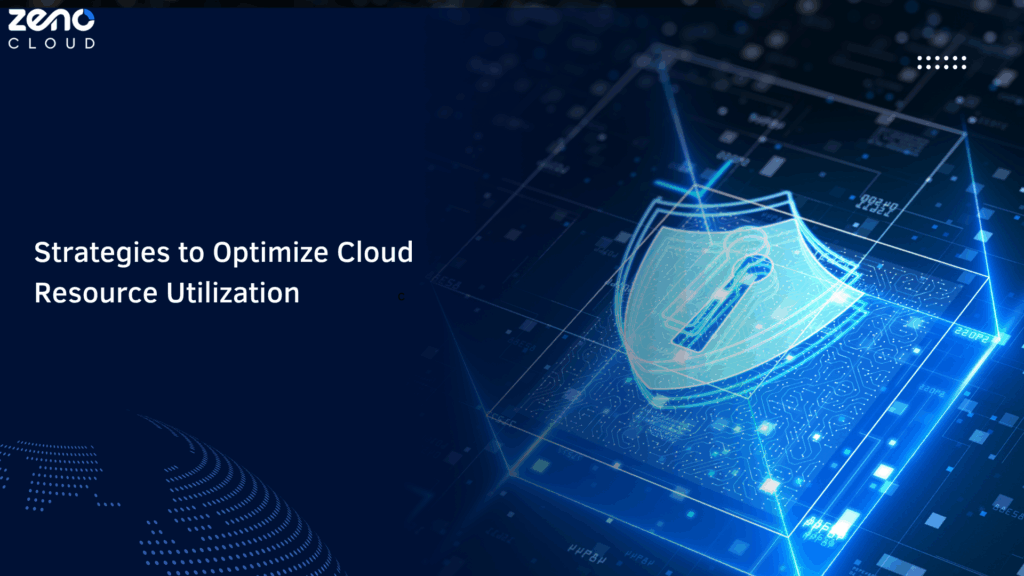
Introduction
Every business today relies on the cloud — for hosting applications, storing data, and running critical operations. But while the cloud promises flexibility and scalability, many companies quietly overspend without realizing it. The reason? They’re not fully aware of how efficiently they’re using their cloud resources.
Cloud resource utilization simply means understanding how much of your cloud infrastructure—like servers, storage, and bandwidth—is actually being used versus what you’re paying for. It’s the difference between a car that runs smoothly on fuel and one that burns extra without going any faster.
The problem is that most organizations set up their cloud infrastructure to handle their busiest days — but those traffic spikes don’t happen all the time. The result is dozens of idle servers consuming money and energy when they’re not really needed. Over time, these small inefficiencies add up to significant waste in monthly cloud bills.
But here’s the good news: optimizing your cloud resources isn’t about cutting corners or compromising performance. It’s about using what you already have, more intelligently. When done right, smart utilization helps you maintain top performance, scale smoothly during demand peaks, and still keep costs predictable and efficient.
2. The Cost Problem in Cloud Computing
One of the biggest advantages of cloud computing is flexibility — you can scale resources up or down in seconds, pay only for what you use, and never worry about hardware limitations. But that same flexibility often becomes the reason businesses overspend on their cloud bills.
Most organizations build their cloud infrastructure to handle peak traffic or worst-case scenarios. While this ensures reliability, it also means that for most of the day, a large portion of those resources sits idle. In other words, companies end up paying for capacity they rarely use.
Common cost pitfalls include:
- Overprovisioning: Running servers that are far more powerful than needed.
- Idle Resources: Keeping virtual machines, test environments, or databases running when they’re not in use.
- Underutilized Instances: Applications using only a fraction of the available CPU or memory, but still being billed for the full capacity.
A 2024 Flexera Cloud Report found that over 35% of cloud spend is wasted due to poor resource management and lack of visibility. That’s millions in unnecessary expenses every year — not because the cloud is expensive, but because it’s easy to lose track of what’s actually being used. To truly take advantage of the cloud’s scalability and cost benefits, businesses need a clear understanding of how their resources are utilized and where inefficiencies lie.
3. What Is Cloud Resource Utilization?
At its core, cloud resource utilization is about understanding how efficiently your business uses the computing power, storage, and network capacity you’re paying for in the cloud. Every cloud environment — whether AWS, Azure, or Google Cloud — gives you access to virtual resources. But if those resources aren’t being used wisely, you could be spending a lot for very little actual output.
Think of it like running a 16-cylinder engine just to drive to the grocery store. The power is there, but you don’t need all of it — and you’re wasting fuel (or in this case, cloud spend).
Cloud utilization helps answer questions like:
- How much of your CPU and memory are actively used?
- Are you storing data efficiently, or paying for unnecessary storage space?
- Is your network bandwidth being fully leveraged, or mostly idle?
Cloud utilization is typically measured through key metrics such as:
- CPU usage – how much processing power is being used.
- Memory utilization – how much RAM your applications are consuming.
- Storage usage – how efficiently you’re managing data across tiers.
- Network utilization – how much of your allocated bandwidth is active.
There’s a strong relationship between utilization and performance. Low utilization often signals overprovisioning — paying for more resources than you need. High utilization, on the other hand, may lead to performance bottlenecks if resources are stretched too thin. The goal is to strike a balance — maintaining high performance while avoiding unnecessary overhead costs.In the visual version of this blog, you could include a simple chart showing how increasing utilization efficiency lowers overall cloud costs, helping readers visualize the connection between smart usage and cost savings.
4. Common Causes of Low Cloud Utilization

Even with the best infrastructure setup, many businesses struggle to get the most out of their cloud environments. The issue isn’t always with the cloud itself — it’s usually how the resources are configured and managed. Here are some of the most common reasons cloud utilization remains low:
1. Overprovisioning
This happens when companies deploy servers or instances that are larger than what their workloads actually need. For example, running an 8-core server for an application that only uses 2 cores on average. While it ensures performance during peak times, most of that capacity sits unused the rest of the time — leading to wasted spend.
2. Lack of Auto-Scaling
Without auto-scaling, resources remain fixed regardless of real-time demand. During low-traffic hours, you’re still paying for the same amount of compute power that you’d need during peak traffic — which means you’re essentially paying for idle time. Auto-scaling allows the system to automatically add or remove instances based on workload, keeping utilization balanced.
3. Idle Workloads
It’s common for businesses to keep development, testing, or staging environments running 24/7, even when no one is using them. These idle workloads quietly consume compute power and storage, contributing to unnecessary cloud costs. Scheduling shutdowns or automating power-off times can solve this easily.
4. Shadow IT & Mismanaged Resources
When teams or departments create and use cloud resources without central visibility or governance, it leads to what’s called shadow IT. Over time, this results in forgotten or duplicate resources consuming costs in the background — from unattached volumes to outdated load balancers and orphaned databases.
5. Inefficient Storage Management
Not all data needs to live on expensive, high-performance storage. Yet, many businesses keep old logs, backups, or inactive project data in premium storage tiers. By moving rarely accessed data to cost-effective options like AWS S3 Glacier or Azure Archive Storage, companies can free up significant budgets without sacrificing access.
When businesses address these issues systematically — through monitoring, automation, and better governance — they not only reduce waste but also improve performance and scalability across their entire cloud ecosystem.
5. How to Measure and Analyze Utilization
You can’t improve what you don’t measure — and the same rule applies to your cloud resources. To optimize cloud spending and performance, you first need clear visibility into how your resources are being used. Fortunately, every major cloud provider offers powerful tools that help track utilization in real time.
Cloud-native monitoring tools like AWS CloudWatch, Azure Monitor, and Google Cloud Operations Suite give you detailed insights into your infrastructure’s performance. They continuously collect metrics, logs, and events to help you understand how your resources behave under different workloads.
When measuring utilization, focus on these key metrics:
- CPU and Memory Usage Trends: Reveal whether your compute instances are oversized or under strain. Low averages often indicate overprovisioning, while constant peaks signal a need to scale up or optimize code.
- I/O and Network Throughput: Show how much data is being read, written, or transferred. This helps detect bottlenecks or underused capacity.
- Storage Performance and Access Frequency: Identify which storage tiers are handling critical data and which hold infrequently accessed files that could be moved to lower-cost storage.
Once these metrics are collected, visualization dashboards make them easier to interpret. Tools like Grafana, Datadog, or native cloud dashboards present complex data through charts, heat maps, and utilization graphs — helping you quickly spot underutilized resources or unusual cost patterns.By regularly monitoring these insights, businesses can make data-driven decisions: scaling down unused instances, reallocating workloads efficiently, and predicting future capacity needs before costs spiral out of control.
6. Strategies to Optimize Cloud Resource Utilization

Once you understand how your cloud resources are being used, the next step is to make them work smarter. Optimizing cloud utilization isn’t about cutting resources — it’s about ensuring every CPU cycle, gigabyte of storage, and bandwidth unit delivers real value. Below are proven strategies that help organizations get the most out of their cloud infrastructure.
- Right-Sizing
Right-sizing means matching your instance types and sizes to actual workload requirements. Instead of relying on guesswork, analyze real usage data to determine whether you’re over- or under-provisioned. Downsizing underutilized instances or switching to more efficient instance families can reduce costs dramatically while maintaining performance.
- Auto-Scaling
Traffic patterns fluctuate, but costs shouldn’t. Auto-scaling automatically adds resources during peak demand and scales them down when activity drops. This ensures your applications stay responsive without overpaying for idle capacity.
- Load Balancing
Load balancers distribute workloads evenly across servers, preventing bottlenecks and ensuring no single resource is overworked while others remain idle. A well-configured load balancing setup improves both performance and utilization efficiency.
- Reserved & Spot Instances
Combining pricing models can be a game changer. Reserved Instances work best for predictable workloads, while Spot Instances are perfect for flexible or temporary tasks. Using both allows you to balance reliability and cost-effectiveness, often cutting compute expenses by up to 70%.
- Storage Tiering
Not all data deserves premium storage. By categorizing data based on access frequency, you can move infrequently used files to lower-cost tiers such as AWS Glacier or Azure Archive Storage. This keeps essential data readily available while significantly reducing storage bills.
- Containerization
Using technologies like Docker or Kubernetes allows you to run applications in lightweight, isolated environments that consume only the resources they need. Containers scale efficiently and optimize resource usage across multiple workloads, minimizing waste.
- Automation & AI Tools
AI and automation tools take optimization to the next level by analyzing usage patterns, forecasting demand, and automatically recommending or executing scaling actions. These insights help teams stay ahead of demand spikes, avoid overprovisioning, and maintain consistent cost control.
When implemented together, these strategies help build a cloud environment that’s agile, scalable, and cost-efficient. The goal is simple — to spend less on what you don’t need, and more on what truly drives performance and growth.
7. Role of Managed Cloud Hosting
While businesses can monitor and optimize cloud resources on their own, the process often requires deep technical expertise, continuous analysis, and constant fine-tuning. That’s where managed cloud hosting comes in — offering a smarter, more hands-free approach to achieving cloud efficiency.
A managed cloud provider continuously monitors infrastructure performance, resource consumption, and cost patterns to ensure that every workload runs at peak efficiency. Instead of juggling multiple dashboards and metrics, businesses get an expert team that handles optimization proactively — from scaling and right-sizing to cost forecasting.
Key Benefits of Managed Cloud Hosting
- Expert Management:
Cloud specialists handle infrastructure performance, resource allocation, and cost optimization using proven frameworks and monitoring tools. This allows businesses to focus on growth rather than infrastructure maintenance. - Predictable Costs:
With managed hosting, cloud expenses become more transparent. Providers analyze billing data, identify inefficiencies, and help you avoid “bill shock” by aligning resources with real usage patterns. - Automated Scaling and Optimization:
Managed solutions use automation to adjust resources dynamically based on live demand — ensuring smooth performance during high traffic and reducing costs when demand drops.
How ZenoCloud Helps?
At ZenoCloud, we take cloud efficiency one step further by combining expert management with data-driven automation. Our managed hosting services include:
- Continuous Cost Monitoring: Real-time tracking and analysis of cloud spending.
- Right-Sizing and Auto-Scaling: Smart adjustment of compute and storage resources based on usage.
- Performance Optimization: Proactive tuning of servers, caching, and workloads to maximize output per dollar spent.
- Transparent Reporting: Easy-to-understand dashboards that show exactly where your money is going — and how much you’re saving.
- With ZenoCloud, businesses gain the confidence that their cloud infrastructure is not just running — it’s performing at its best, all while keeping costs under control.
10. Conclusion
Cloud cost savings don’t come from spending less — they come from spending smarter. The real power of the cloud lies in understanding how your resources are being used and ensuring every part of your infrastructure delivers value. By focusing on resource utilization, businesses can achieve the perfect balance between performance and cost efficiency. From right-sizing and auto-scaling to continuous monitoring and automation, optimization isn’t a one-time effort — it’s an ongoing process that keeps your infrastructure lean, agile, and ready for growth.
Partnering with a managed hosting provider like ZenoCloud takes this a step further. With proactive cost monitoring, real-time scaling, and transparent insights, ZenoCloud ensures your cloud environment runs at its best — efficiently, securely, and cost-effectively.
Ready to optimize your cloud costs? At ZenoCloud, we believe smart infrastructure isn’t about spending more — it’s about spending right. Discover how ZenoCloud helps you optimize cloud costs while improving reliability and performance.




